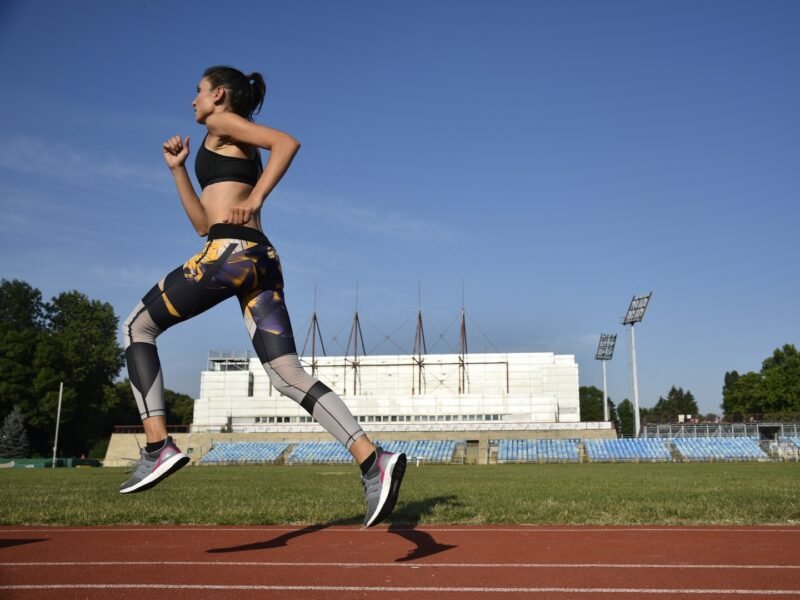Why Are Runners So Skinny? (3 Main Reasons)
You watched an athletic competition or have been to a marathon and you have noticed that all the best long-distance runners are so skinny.
You must have wondered why that is so.
In this article, I will answer the question of why are runners so skinny, as well as some other similar questions.
Generally speaking, runners are very skinny due to the way they train. After long runs, the body depletes its glycogen reserves and uses fat as a source of energy. This results in more efficient and endurance but leaner muscles.
Below I will explain in detail why are runners so skinny.

1. They exercise often, and their workouts are long
One of the main reasons why runners are very skinny is their training habits.
Elite runners exercise at least 6 days a week and their workouts on average last longer than 2 hours.
This way of training enables the body to regularly remove fat, and have no time to store it because:
- During the first 90 minutes of running, the body uses glycogen as fuel (stored carbohydrate stores in muscles and liver).
After it depletes its glycogen stores, which happens on average after 90 minutes of running, the body starts using fat as a source of energy.
This is that moment when you “hit the wall”.
Since the average workout of professional runners is more than two hours long, glycogen stores and large amounts of fat will be depleted. - After a workout, runners replenish the glycogen they depleted during a workout through food and food supplements.
Within the first 24 hours, the muscles of runners take all the carbohydrates from the bloodstream.
Due to that, little or no carbohydrates are able to be converted to fat. - If a runner runs 5 to 6 times a week, they will very rarely come to the point where glycogen reserves are high enough for carbohydrates to convert into fats.
Due to that, most runners who exercise 5 to 6 times a week have their body fat drop below 15% for men and 20% for women.
Research has shown that the percentage of body fat in male recreational marathon runners heavily affects race results, regardless of the average weekly mileage and the average pace during training.

2. They have more efficient but leaner muscles
Muscles are made up of slow and fast-twitch fibers.
Slow-twitch muscle fibers (type I) are fibers that contract slowly and are very endurant, that is, they have great resistance to fatigue.
Fast-twitch muscle fibers (type IIA and IIB) are capable of producing greater force than slow-twitch muscle fibers, but they also get tired much more quickly.
| Type of fiber | Contraction speed | Time to reach maximum power | Fatigue |
|---|---|---|---|
| I (slow-twitch fibers) | slow | 100 milliseconds | slow |
| IIA (fast-twitch fibers) | fast | 50 milliseconds | fast |
| IIB (fast-twitch fibers) | very fast | 25 milliseconds | fast |
Tip
Slow-twitch muscle fibers are mainly activated during less intense activities such as easy and long running. On the other hand, fast-twitch muscle fibers are mainly activated during explosive and short activities, but they also get tired much more quickly.
Running a marathon and any other activity that requires endurance primarily relies on slow-twitch muscle fibers.
Meanwhile, sprinting, such as a 100-meter race, relies almost exclusively on fast-twitch muscle fibers. Basically, the more activity is “explosive”, the more “bulkier” an athlete will be.
Therefore, the muscles of elite long-distance runners are leaner but are more efficient.
Read more: Key Muscles Used in Running (8 Main Muscle Groups)

3. They are genetically predisposed to run long distances
Professional athletes are generally genetically predisposed to the sport they train.
Example
All Olympic swimmers are tall and have long arms, big palms, and feet, implying is ti because of swimming. However, that is wrong. The reason why they are shaped like that is the genes they were born with. As a result of that, the most elite level of athletes consists only of those with this genetic “advantage”.
If you observe runners who finish a marathon, you will notice that many of them are not that skinny, that is, they are not built like professional marathon runners.
Therefore, although many assume that running a marathon will make you skinny, that does not have to be the case.
Reality is in fact exactly the opposite at the elite level of athletics.
Elite marathon runners ended up competing in their sport due to their genetic predispositions, that is, their body constitution because they were naturally much better at running long distances than their peers.

Why do my muscles get leaner from running?
Your muscles can get leaner from running due to the way you run.
If your goal is to shape your body and gain muscle mass, you should run shorter and faster distances, such as strides or intervals up to 200 meters.
However, if your goal is to run a marathon, you should do a lot of longer, less intense workouts, which will lead to leaner muscles.
The reason why elite long-distance runners are skinny and have leaner muscles is due to the way they train.
Long-distance running mainly activates slow-twitch muscle fibers and makes muscles leaner but more efficient and endurant.
This is also the most popular myth in the fitness industry.
They argue that long-distance running uses up all glycogen, and our body begins to burn muscle as fuel. However, there is actually no evidence that backs this up.
Why are sprinters so muscular and long-distance runners so skinny?
Sprinters that compete in the 60 meters, 100 meters, and 200 meters are usually very muscular because big and strong muscles can produce a lot of strength in a very short amount of time.
Meanwhile, for long-distance runners, this would be a drawback. Every additional pound that they have to carry in a marathon, or even in the 1500 meters, makes the race more difficult for them.
Instead, long-distance runners will train in a way that will make their muscles more efficient and durable by, for instance, increasing the size of capillaries through aerobic training.
Example
Both sprinters and long-distance runners do a lot of strength training. Sprinters do a smaller number of reps with greater resistance to develop larger and stronger muscles.
On the other hand, long-distance runners do more repetitions with less resistance to make their muscles more efficient and endurant.
Read more: Strength Training for Runners (Top 19 Workout Exercises)

Matea Matošević
Hi, I’m Matea! I’m an Olympic Marathon Runner, founder, and writer behind OLYRUN.com. On this site, I provide help in the form of my knowledge and experience to all who love running and active living. Read more…

